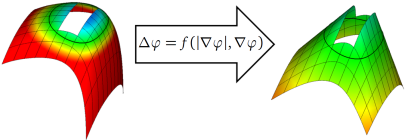

- Theoretical modelling
- Flows of immiscible fluids
- Particle flows
- Development of higher order numerical methods
Exemplary topics
Disperse fluid systems are important components of many processes in production and energy conversion. Liquids involved in production processes of bio- and chemical engineering, particularly, polymer powders by spray drying and in the aeration of liquids with dissolved proteins and bacteria, may exhibit viscoelastic behaviour.
In this PHD-project we are going to simulate the oscillating behaviour of a viscoelastic droplet using a high-order Discontinuous-Galerkin-method (DG) employing a sharp interface approach. Within the PHD-project we want to
- create a working environment for viscoelastic flow problems in the BoSSS framenwork
- develop new handling methods for the objective part of the constitutive equations based on ideas for Reynolds stress models in turbulence research
- combine the viscoelastic flow environment with the extended DG framework of BoSSS
- gain first insights into the oscillatory behaviour of viscoelastic droplets
Contact: Anne Kikker, M.Sc.
We use our cut cell DG approach to simulate moving bodies in an immersed boundary context. For two dimensional flow problems, like the flow around an oscillating cylinder in a channel and a disk falling in incompressible fluid, very good agreement with literature could be yield by using a significant smaller amount of DoFs for higher order approximations. Hereby the flow is modeled by using incompressible Navier-Stokes equations. The moving body is assumed to be rigid and its motion is calculated by solving Newton-Euler equations.
Contact: Dennis Krause, M.Sc.
The objective of the project is to investigate the thermodynamic behavior of electrolyte solutions whose constituents react to form solids. Particularly, we are interested in modeling the thermodynamic behavior of calcium carbonate supersaturated solutions. For this purpose, we perform numerical simulations in commercial fluid dynamics softwares and compare the results with experimental information.
Contact: Dr. Martina Costa Reis
This project aims at the simulation of multiphase flows, which are mainly driven by surface tension and inertia forces. Examples of such flows are interface instabilities, rising bubbles and colliding droplets. Multiphase problems introduce due to the discontinuity of the fluid properties at the interface, kinks in the velocity field and jumps in the pressure field. The extended Discontinuous Galerkin (XDG) method allows a sub-cell accurate representation of the fluid interface. Thus allowing a sharp representation of the kinks and jumps for the flow properties.
Contact: Martin Smuda, M.Sc.
In the BoSSS-Framework we model the interface in multiphysics simulations by a level-set function. This allows topological changes of the interface and avoids an explicit tracking of the interface contour. The motion of the interface is then modeled via a global advection equation of this level-set. However in this context two issues arise:
- The level-set is usually chosen to be signed distance. This reduces the error in determining the interface position and in the motion of the interface. This means, we require a reinitializition procedure to regain the signed-distance property.
- The velocity of the interface may only be locally defined at the interface, e.g. in solidification problems or in multiphase flows, where the velocity may have a jump or kink at the interface. Thus we require a procedure to extend the velocity of the interface into the rest of the domain.
Contact: Thomas Utz, M.Sc.


Extended discontinuous Galerkin (XDG) methods, also referred to as unfitted discontinuous Galerkin (DG) or cut-cell DG are developed to discretize partial differential equations (PDE) on moving domains and/or with discontinuous parameters.
One example for such problems is fluid-structure interaction where moving or deforming parts of the geometry can be represented numerically by intersecting the geometric boundary with a fixed background mesh. Another example is multi- or two-phase flow, i.e. mixtures of two immiscible fluids like oil and water or water and air, which are separated by a dynamic boundary. There, one has to consider discontinuities in density and viscosity at the fluid interface, which induce discontinuities in the solution variables, i.e. in pressure and velocity. For such low-regularity solutions, a usual high-order DG method would degenerate to a convergence rate of about one, while the XDG method is performs with a high order of accuracy.
Furthermore, the XDG method can also be used to eliminate the cumbersome manual task of meshing, since an arbitrarily complicated geometry can be embedded on a Cartesian background mesh.
Despite very promising benchmark results, the XDG method is still requires a lot of research before it can be applied to industrial-scaled problems. In particular, we are investigating multiple ways to capture the motion of the embedded interface/boundary (level set methods), numerical solvers and pre-conditioners for the especially ill-conditioned systems which arise from the XDG discretization as well as node-level and parallel performance.
Contact: Dr.-Ing. Florian Kummer
In this project a new approach to the free boundary value problem of an oscillating droplet is taken. The goal is the derivation of a new set of equations describing the surface motion. The approach is based on the recently developed mathematical technique known as “Unified Transform Method” (Fokas' Method) which allows to reformulate certain PDEs into Integro-Differential Equations (IDEs). Using this technique, it is possible to formulate a new pair of governing equations which are valid for almost arbitrary drop shapes and, additionally, takes viscous effects into account.
Contact: Dipl-Math. Dominik Plümacher
